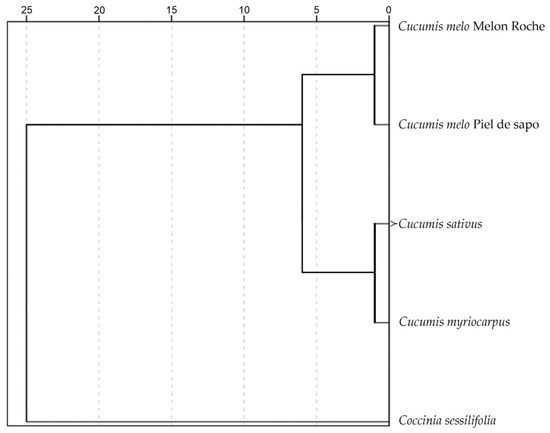Abstract
The Cucurbitaceae is a monophyletic family with close to 1000 species of climbers, including important agronomic species and varieties characterized by tendrils and pepo fruits. The seed’s morphology is varied, and the development and structure of the seed coat have been described in detail on some species. Overall description of the seed shape is based on terms comparing it with geometric figures, but quantitative methods are lacking in the literature. Here we apply a general morphological analysis to seeds of representative genera of the Cucurbitaceae, followed by curvature analysis in the poles and symmetry analysis. These methods are useful for the quantitative description of seed shape and the comparison between species and varieties. Differences between species were found for most morphological measurements, as well as for symmetry and curvature values. The comparison between three species of Cucumis (Cucumis sativus, C. myriocarpus and C. melo) and two varieties of C. melo reveals differences between species and varieties both in curvature and symmetry. The results obtained from both methods, curvature and symmetry analysis, form similar groupings in a cluster analysis. The methods described here were applied for the identification of agronomic varieties and the quantitative description of seed shape in taxonomy.
1. Introduction
In the life cycle of plants, seeds have a range of functions concentrated in a reduced volume. They have the capacity to survive during adverse environmental conditions, and guarantee protection, nutrition and dispersal of the embryo. Seed shape is related to all these functions and is the result of the integration of protective, nutritional and transport tissues with an adequate surface to volume ratio. In addition, seed shape is the result of a complex developmental process defined by the ovule type and the relation of the ovule with the ovary and fruit structures. The morphological and functional diversity of seeds represents the complexity of plants [1].
The Cucurbitaceae Juss. includes ca. 100 genera of herbaceous annual vines and perennial lianas, with some caduciform succulent species reported for Apodanthera Arn. Ref. [2] and the tree Dendrosicyos socotranus Balf.f., endemic to Socotra Islands. The family includes fruits and vegetables agriculturally important such as Citrullus lanatus (Thunb.) Matsum. & Nakai (watermelon), Cucumis melo L. and C. sativus L. (melons and cucumbers, respectively), Cucurbita moschata Duchesne (pumpkin), C. pepo L. (ornamental gourds and zucchini), Lagenaria Ser. (L. siceraria (Molina) Standl. is the calabash or bottle gourd traditionally used as water container) and Coccinia Wight & Arn. (scarlet gourds) [3,4]. Luffa Mill. (L. aegyptiaca Mill. and L. acutangula (L.) Roxb.) are cultivated and eaten as vegetables but they are also the source of the loofah scrubbing sponge.
Members of the Cucurbitaceae are mainly distributed in tropical and subtropical regions with relatively few species naturally inhabiting the temperate regions of the world. Some species are invasive like paddy melon (Cucumis myriocarpus Naudin), bitter cucumber (Citrullus colocynthis (L.) Schrad.) and camel melon (C. lanatus (Thunb.) Matsum. & Nakai) in Australia [5] or Sicyos angulatus L. in Europe [6]. The family is monophyletic, and it has its origin in the Asiatic continent [7,8,9]. Subfamilies are not recognized in the recent classifications [7,8,9], and the application of modern molecular taxonomy methods has resulted in the distribution of genera in 15 tribes [9]: Actinostemmateae, Benincaseae, Bryonieae, Coniandreae, Cucurbiteae, Gomphogyneae, Indofevilleeae, Joliffieae, Momordiceae, Schizopeponeae, Sicyoeae, Siraitieae, Thladiantheae, Triceratieae and Zanonieae.
Two of the ancient tribes (the Gomphogyneae and the Actinostemmatae) are now almost restricted to Asia, while a third, the Triceratieae, is mainly Neotropical. Species belonging to nine of these tribes occur in Malaysia [10], while the native European cucurbit flora is limited to a single clade, Bryonieae [7].
In the Cucurbitaceae, ovules are anatropous, bitegmic and crassinucelate [11,12]. The seeds are mainly oval or ellipsoid, often compressed and with bilateral symmetry along the major axis. The tegmen collapses in the curse of development and testa alone forms the seed coat. The development and structure of the seed coat has been studied in several genera [13,14,15,16,17,18,19,20,21].
Seed morphology has been traditionally used in taxonomy with variable success in diverse families of plants [22,23,24,25]. Studies of seed morphology are based on the combination of different qualitative characters and directed towards understanding the phylogenetic relationships between taxonomic groups. In addition, two particular strategies applied are as follows: (1) A general description of seed morphological types and, (2) The definition of surface characters, such as for example seed tubercles in the Caryophyllaceae [26,27,28,29,30,31]. In both cases, descriptions are based on adjectives, and progress is often hampered by the lack of quantification methods. In the Cucurbitaceae, shape descriptions are based on the comparison with geometric figures or objects resembling them and frequently used terms include globose, ovoid and pyriform (Halosicyos Mart. Crov. [17]; Indofevillea Chatterjee, Siraitia Merr. [17]), pear-shaped (Ampelosicyos Thouars [17]; Diplocyclos palmatus (L.) C. Jeffrey [20]), obovoid (Ibervillea Greene ex. Tumamoca Rose [17], Bryonia dioica Bojer [20]), oblong (Melothrianthus Mart. Crov. [17]; Benincasa hispida (Thunb.) Cogn., Lemurosicyos variegatus (Cogn.) Keraudren, Ruthalicia longipes (Hook.f.) C. Jeffrey [20]); oblong-obovoid (Citrullus colocynthis (L.) Schrad. [20]), and suborbicular (Fevillea L. ex. Anisosperma Manso [17]). Nevertheless, there are no characteristic morphological types for any of the tribes, and almost there is no morphological rule of general application in taxonomy other than smaller and winged seeds occur preferentially in the basal clades. Heneidak and Khalik used a series of characters from seeds, including size and shape, as well as others based on details of the seed coat surface to contribute to a taxonomic key for some species of the Cucurbitaceae [20]. Their results showed monophyly of the tribes Bryonieae, Coniandreae and Luffeae, but in order to make morphological methods of broader application, more seed characteristics may be defined that can be subjected to a quantitative geometric analysis. Thus, seed shape description based on quantitative methods may contribute to the application of seed morphology in taxonomy.
A quantitative method based on the comparison with geometric models has been applied to describe, quantify and compare seed shape in diverse families and species [32,33,34,35]. The application of this method to the seeds of the Cucurbitaceae showed the similarity that many seeds have with ellipses and ovoids [35] and gave quantifications of shape for some species. For example, seed images of many species of Cucurbita L., Coccinia Wight & Arn., Bryonia L., Trichosanthes L., Citrullus Schrad. ex Eckl. & Zeyh., Melothria L., Sicyos L., Acanthosicyos Welw. ex Benth. & Hook.f. and Dendrosicyos Balf.f. adjusted to an ovoid, while diverse species of Cucumis L., as well as Echinocystis lobata (Michx.) Torr. & A.Gray and Lagenaria sphaerica (Sond.) Naudin adjusted better to ellipses of variable aspect ratio. New methods based on Elliptic Fourier Transform (EFT) make it possible to design models that are more specific for the seeds of given species than canonical, well-known geometric figures [36]. In addition, the application of curvature analysis may also improve the seed shape description. Curvature is the rate at which the unit tangent vector is changing with respect to arc length [37,38,39,40]. Curvature measurements are based on methods developed for roots analysis in Arabidopsis Heynh. in Holl & Heynh. (Brassicaceae) [37,38], wheat, grape and Silene seeds [39,40]. Finally, a new aspect related to seed geometry is the quantification of symmetry in the seed images. We present here for the first time a protocol for the measurement of symmetry and its application to diverse species of the Cucurbitaceae. The application of these methods may contribute to the taxonomy of this family.
2. Materials and Methods
2.1. Plant Material
The seeds analyzed belonged to seven genera (Bryonia, Citrullus, Coccinia, Cucumis, Cucurbita, Ecballium, Momordica and Sicana), of which Cucumis is represented by three species (C. melo, C. myriocarpus and C. sativus) and two cultivars of C. melo (Piel de sapo and Melon Rochet). The seeds of Bryonia dioica and Cucumis myriocarpus were, respectively collected in the forest and fields of Villanueva de Gómez (Ávila, Spain); Citrullus lanatus, Cucumis melo var. Melon Rochet and Piel de sapo, and Cucumis sativus, were obtained from local suppliers. Seeds of Ecballium elaterium (L.) A.Rich. were collected in the IRNASA-CSIC. Sicana odorifera (Vell.) Naudin seeds were obtained from local growers at Puyo (Pastaza, Ecuador). The images of Momordica sp. and Coccinia sessilifolia were obtained from the web pages of RBG Kew.
2.2. Seed Photographs
Images of the seeds were taken with with a Nikon Z6 camera (Nikon, Tokyo, Japan), equipped with an objective AF-S Micro NIKKOR 60 mm f/2.8G ED (Nikon, Tokyo, Japan). Seed images of Momordica sp. (originally labelled as Coccinia rehmannii) and C. sessilifolia were from Elly Vaes, RBG Kew. For curvature and symmetry analysis, the seeds were oriented vertically, with their apical poles, containing the embryo above.
2.3. Model Design by Elliptic Fourier Transform (EFT)
The model used for shape comparison of Cucumis species and varieties resulted from the EFT expansion with six harmonics corresponding to 25 points taken regularly along a seed silhouette of C. sativus. Closed curves reproducing the seed silhouettes were obtained by the application of the protocol of EFT as described [36]. The Mathematica code with the Fourier expansion corresponding to a seed of C. sativus and the resulting figure used as the model for shape comparison are available at Zenodo (see Supplementary Materials).
2.4. Seed Shape Quantification by Comparison with a Model
The model was superimposed to the seed image, and two copies of the combined image were made, one with the model in white, and the other with the model in black (Figure 1). Image areas were quantified in Image J153. The area obtained with the model in black corresponds to the total area occupied by the seed image and the model, while the area with the model in white represents the shared area between both figures. J index is the percent of similarity between the seed image and the model and is calculated as:
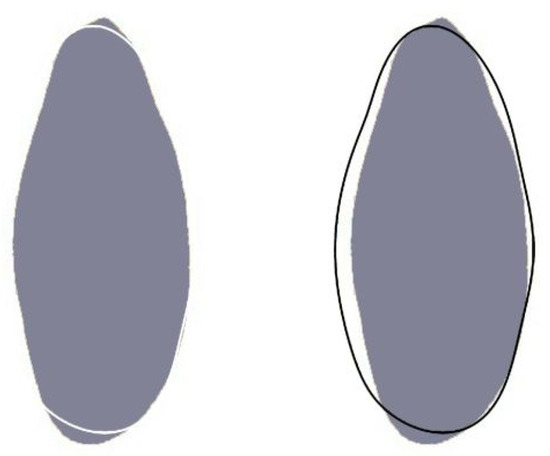
Figure 1.
The two images used for calculation of J index are formed by the superposition of the seed image (shown here in grey) with a geometric model. In the image on the left, the model is shown by a white line, while it is in black on the right. The image on the left gives the measurement of shared area, while the image on the right gives total area occupied by both the image and the model. J index gives a measure of the percent similarity between the seed image and the model and is calculated as (Shared area)/(Total area) × 100.
2.5. Curvature Analysis
A series of points was taken for the image of curves defining the upper and lower part of the seeds with Image J. The corresponding Bézier curve and curvature analysis were obtained according to published protocols [37,38,39,40] (See Supplementary Materials). Curvature is given in mm−1; thus, a curvature of 1 corresponds to a circumference of 1 mm, and a curvature of 10 to a circumference of 100 microns (0.1 mm).
2.6. Symmetry Calculation
Bilateral symmetry of a seed was calculated based on the protocol to obtain J index. J index is the percentage of similarity between a plane figure of a seed and the corresponding geometric model [32,33,34,35]. The model used to calculate bilateral symmetry is the specular image of the seed silhouette obtained with the command reflect horizontally in Corel PhotoPaint (Figure 2).
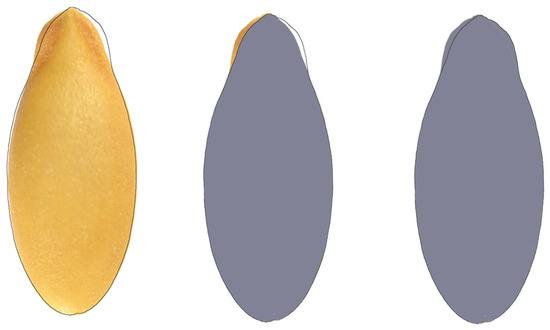
Figure 2.
A summary of the protocol used to measure bilateral symmetry in a seed of Cucumis melo. Left: Seed image with model superimposed. The model is the silhouette resulting from the horizontal reflection of the seed image. Center: Seed image with model superimposed and common region in gray. Right: Seed with Model from its own silhouette superimposed in gray. Differences in area between the two images (total and shared area) give a measure of symmetry.
Similarly to the J index, Symmetry index is given by the following equation:
In the equation, T is the total area resulting from the sum of the image of a seed silhouette and the specular image of it superimposed on a minimum surface area and S is the area shared by both. Thus, in the cases of maximum symmetry, both images coincide and S/T = 1. The model in this case is obtained as the silhouette resulting from the horizontal reflection of the seed image.
2.7. Statistical Analysis
Given the heterogeneity in sample sizes or in their distributions, Kruskal–Wallis test was used to identify significant differences between populations for the measured variables. Statistical analyses were performed with IBM SPSS statistics v28 (SPSS 2021). Coefficients of variation were calculated according to [41].
The Euclidean distance and Ward algorithm for clustering were used to calculate the dendrogram. The matrix used for the analysis contained the data for symmetry values.
3. Results
This section is divided into four sub-sections. Section 3.1 presents data related to the general morphological measurements conducted on eleven species belonging to seven genera corresponding to tribes Benincaseae (Citrullus, Momordica, Cucumis), Cucurbiteae (Cucurbita and Sicana) and Bryonieae (Bryonia and Ecbalium). Section 3.2 and Section 3.3 contain data on curvature and symmetry analysis for these genera, except Cucumis. A morphological analysis including curvature, symmetry and the comparison by a geometric model is applied to three species and two varieties of Cucumis in Section 3.4.
3.1. General Morphological Measurements
Table 1 contains a summary of the mean values for area (A), perimeter (P), length (L), width (W), circularity (C), aspect ratio (AR), roundness (R) and solidity (S) for seeds of the species and varieties analyzed. There were significant differences between species for all measurements. Cucumis myriocarpus and Ecballium elaterium had the lowest area values; while Sicana odorifera had the highest. Aspect ratio was highest in the two varieties of Cucumis melo, and there were significant differences in aspect ratio between this species and C. sativus and C. myriocarpus, that had the lowest value for aspect ratio in this genus. Coccinia and Momordica had significantly lower values in solidity whereas the highest values were found in Cucumis sativus.

Table 1.
Mean values of area (A), perimeter (P), length (L), width (W), circularity (C), aspect ratio (AR), roundness (R) and solidity (S) in species and varieties of the Cucurbitaceae. Between parentheses, coefficient of variation. Different lowercase letters indicate differences between populations in the same column.
Solidity values are the more conserved between groups oscillating between 0.961 and 0.993 (coefficients of variation between 0.1 and 0.9), being higher in the four species of Cucumis and the two species of tribe Bryonieae (Bryonia and Ecbalium), than in the rest of species.
3.2. Curvature Analysis
Table 2 contains a summary of the curvature values including the maximum, mean and maximum to mean ratio for both upper and lower sides of the seeds. In addition, the last column presents the ratio between maximum curvature values in the upper (apical) and lower (basal) part of the seed. Low values of curvature ratio were associated with low polarity (less difference between the poles), while high values represent high polarity in the seeds. Significant differences in curvature ratio were found between Momordica sp. (lowest value) and the rest of the species, in one hand and also between the groups formed by Citrullus lanatus, Coccinia sessilifolia, Cucumis melo cv. Piel de sapo and Cucurbita pepo (higher values) and Cucumis sativus and Ecbalium elaterium (lower values).

Table 2.
Curvature values in the upper and lower part of the seeds for different species and varieties (between parentheses, number of seeds analyzed). Different lowercase letters indicate differences between populations in the same column.
The rest of this section is dedicated to the analysis of curvature in representative species of the Cucurbitaceae (Figure 3, Figure 4, Figure 5, Figure 6, Figure 7, Figure 8, Figure 9 and Figure 10). The results corresponding to Cucumis species and varieties will be analyzed with more detail in Section 3.4.
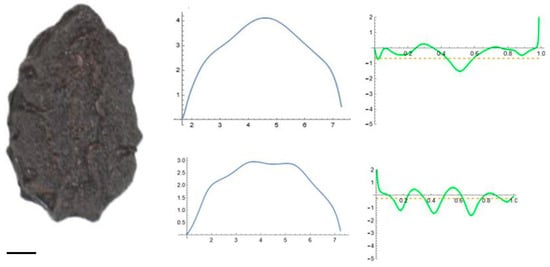
Figure 3.
Left: a seed of Momordica sp. Right: Curvature analysis; above: Bézier curve and curvature in the upper side; and below, Bézier curve and curvature in the lower side of the seed. Bar represents 1 mm.
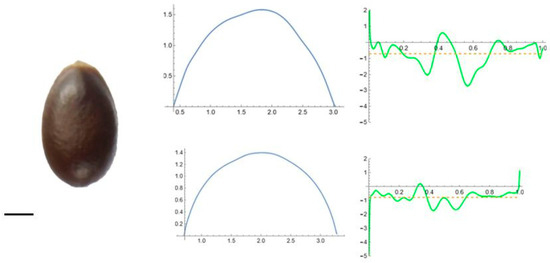
Figure 4.
Left: a seed of Ecbalium elaterium. Right: Curvature analysis; above: Bézier curve and curvature in the upper side; and below, Bézier curve and curvature in the lower side of the seed. Bar represents 1 mm.
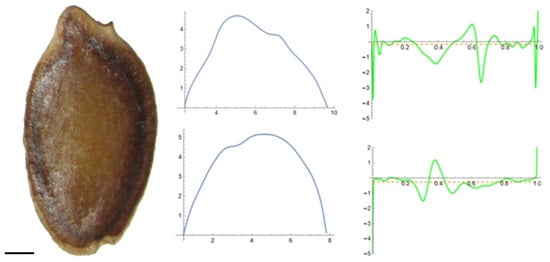
Figure 5.
Left: a seed of Sicana odorifera. Right: Curvature analysis; above: Bézier curve and curvature in the upper side; and below, Bézier curve and curvature in the lower side of the seed. Curvature points superior to the unity are present both in the upper and lower sections of the seed. Bar represents 1 mm.
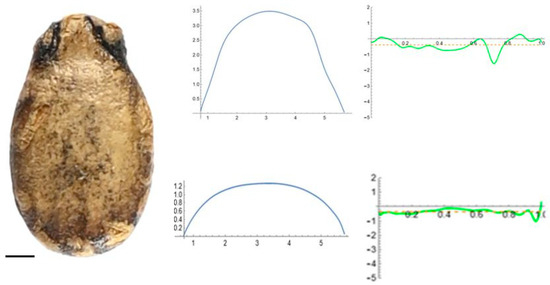
Figure 6.
Left: a seed of Citrullus lanatus. Right: Curvature analysis; above, Bézier curve and curvature in the upper side; and below, Bézier curve and curvature in the lower side of the seed. Bar represents 1 mm.
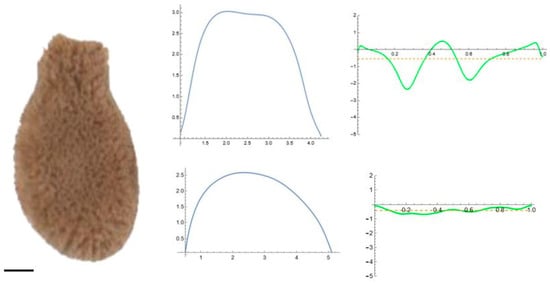
Figure 7.
Left: a seed of Coccinia sessilifolia. Right: Curvature analysis; above, Bézier curve and curvature in the upper part; below, Bézier curve and curvature in the lower part of the seed. Bar represents 1 mm.
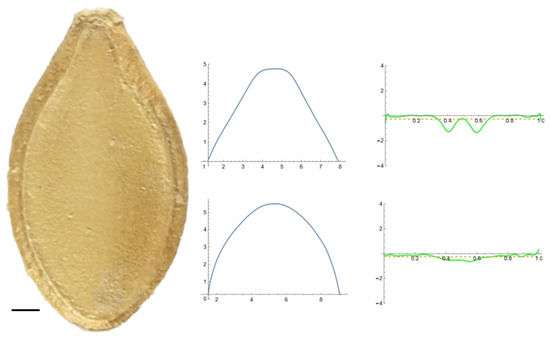
Figure 8.
Left: a seed of Cucurbita pepo Right: Curvature analysis; above, Bézier curve and curvature in the upper part; below, Bézier curve and curvature in the lower part of the seed. Bar represents 1 mm.
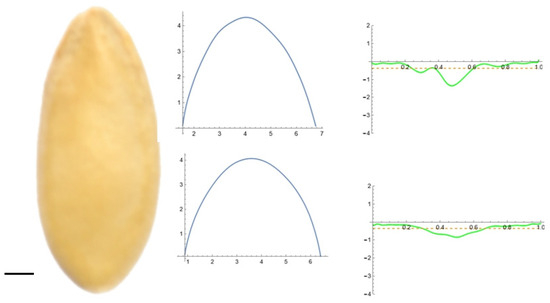
Figure 9.
Left: a seed of Cucumis melo cv. Melon Rochet. Right: Curvature analysis; above: Bézier curve and curvature in the upper part; below, Bézier curve and curvature in the lower part of the seed. Bar represents 1 mm.
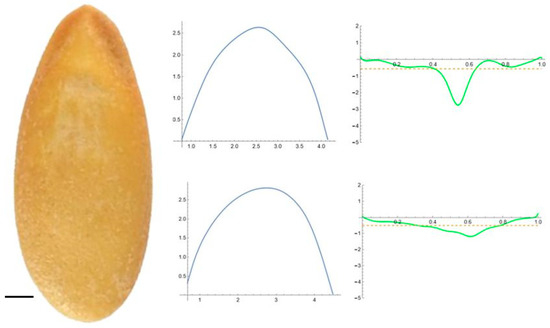
Figure 10.
Left: a seed of Cucumis melo cv. Piel de sapo. Right: Curvature analysis; above: Bézier curve and curvature in the upper part; below, Bézier curve and curvature in the lower part of the seed. Bar represents 1 mm.
The seeds of Momordica sp. had the lowest curvature ratio between apical and basal poles. In their apical poles, they presented a single inflection point, in contrast with two or three inflection points corresponding to respective curvature peaks in their basal poles (Figure 3).
Ecbalium elaterium and Sicana odorifera had values of curvature ratio superior to Momordica sp. but lower than the other species. One or two points of inflexion corresponding to respective curvature peaks are observed in the apical and basal poles of seeds of Ecbalium elaterium (Figure 4) while two points of inflexion are commonly observed in both poles in Sicana odorifera (Figure 5).
The seeds of Citrullus lanatus, Cucurbita pepo and Coccinia sessilifolia had curvature ratio between the apical and basal poles superior to the other species. Figure 6 shows a seed of C. lanatus and the results of the corresponding analysis of curvature. The seeds presented inflection points variable in number and size in their apical side, while in their basal side curvature values were almost constant, and the silhouette approached the figure of an arc of circumference of radius equal to the inverse of average curvature, between 1 and 2 mm in case of this image (curvature values in the lower part between 0.5 and 1).
Two maximum curvature values were observed in the upper part of the seed in Coccinia sessilifolia, while the basal part presented some asymmetry with higher curvature values (lower radius) on one side (Figure 7).
Some seeds of Cucurbita pepo also presented a small plane region in the apex giving two maximum points of curvature (Figure 8). In the basal region, curvature values were more constant.
3.3. Symmetry Analysis
Table 3 presents the results of the quantification of symmetry in the species of the Cucurbitaceae. Coccinia sessilifolia and Ecbalium elaterium showed significantly the lowest and highest values on symmetry, respectively.

Table 3.
Symmetry values (percent) in the seeds of the species and varieties of Cucurbitaceae analyzed. N is the number of seeds analyzed. Between parentheses, coefficients of variation. Different lowercase letters indicate differences between populations in the same column.
3.4. Morphological Analysis in Cucumis
3.4.1. Curvature Analysis
Curvature was more variable in Cucumis sativus than in C. melo. The seeds of the two varieties of Cucumis melo presented regular Bézier curves both in the upper and lower sides. Most seeds presented a single inflection point in the upper side with single peaks of maximum curvature in the apical region, and smaller peaks in the central part of the basal side (Figure 9 and Figure 10).
In contrast, the seeds of C. sativus had patterns of curvature more diverse, predominantly with two notable peaks in the upper pole and two peaks less marked in the lower pole (Figure 11).
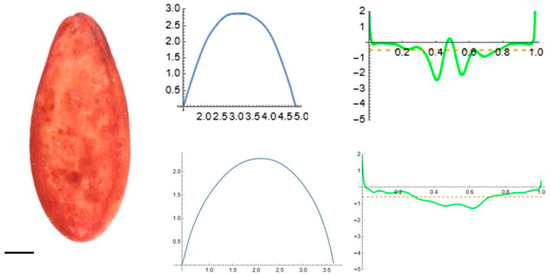
Figure 11.
Left: a seed of Cucumis sativus. Right: Curvature analysis; above: Bézier curve and curvature in the upper side; below, Bézier curve and curvature in the lower side of the seed. Curvature points superior to the unity are present both in the upper and lower sections of the seed. Bar represents 1 mm.
Maximum and mean curvature values in the upper pole were superior in C. melo cv. Piel de sapo, and no differences were detected between curvature in the upper pole between the seeds of C. sativus and those of C. melo Melon Rocher (Table 2).
3.4.2. Morphological Comparison by Models Based on EFT Curves Reproducing the Seed Silhouettes
The curves corresponding to EFT expansions reproduced well the silhouette of seeds of all the species. The model obtained for Cucumis sativus was tested against seeds of Cucumis sativus, Cucumis melo CV. Melon Rochet and Piel de sapo and C. myriocarpus with the results presented in Table 4. Significant differences were found for the shape comparison between the three species. C. myriocarpus seeds resemble C. sativus more than the seeds of varieties of C. melo.

Table 4.
Values of J index resulting from the comparison of a model from Cucumis sativus tested against seeds of C. sativus, C. melo cv. Piel de sapo and C. melo cv. Melon Rochet. Different lowercase letters indicate differences between populations in the same column.
3.4.3. Symmetry Analysis
Similar to the results of morphological comparison, symmetry analysis showed differences between the three species. Highest symmetry values were obtained in Cucumis sativus, intermediate in C. myriocarpus and the lowest values correspond to the two varieties of C. melo (Table 5).

Table 5.
Results of symmetry analysis in species of Cucumis and varieties of C. sativus. Different lowercase letters indicate differences between populations in the same column. Between parentheses, coefficients of variation.
3.4.4. Morphological Measurements in Relation with the Taxonomy of Cucumis
Among the quantitative morphological characters analyzed, both J index with specific models and Symmetry index give results coherent with the taxonomic relationship in Cucumis. The dendrogram in Figure 12 shows the relationship between Cucumis species and cultivars based on the values for symmetry indicated in Table 3 (for Coccinia sessilifolia) and Table 5 (C. melo var. Melon Rochet and Piel de sapo, C. myriocarpus and C. sativus). The two agronomic cultivars group together and separated from another cluster containing C. myriocarpus and C. sativus. A similar figure resulted from the data corresponding to J index in the shape comparison with the model from the EFT expansion with six harmonics corresponding to 25 points taken regularly along a seed silhouette of C. sativus.
4. Discussion
Recent advances in plant science have been more concentrated in biochemistry, genetics and the corresponding -omics approaches, rather than the classical morphological descriptions. Nevertheless, detailed quantitative morphological descriptions are needed for understanding plant-environmental interactions [47], as well as gene function and the relationship between gene activity and organ and tissue development [48]. In addition to their agronomic interest worldwide, the Cucurbitaceae have a background of morphological and phylogenetic studies and constitute an interesting system to study seed morphology. The seeds of the Cucurbitaceae have diverse shape and size (see Figures S1 and S2 in the Supplementary material). Wings develop in tribes Triceratieae, Gomphogyneae and Zanonieae that can be unilateral (Gerrardanthus, Neoalsomitra, Zanonia), bilateral (Siolmatra), or peripheral (Alsomitra). Wings are considered ancestral characters in this family, together with samara and capsule fruit types [9]. Berry and pepo fruit types, associated with higher solidity values in the seeds, are characteristic of the more recent clades.
Winged, round, lens and irregular shaped seeds are more frequent in the ancient clades, while the obovoidal plane shape, already present in some ancient clades such as Actinostemmatae, Indofevilleae, Thladianteae and Siraitieae, is predominant in recent tribes. Seed size is, in general, higher in the ancient clades. Data of seed size reported here (average length and width of 10.5 and 5.4 mm) are comparable to those in the seed volume database elaborated by Ganhao et al. [49] that contains the values of length, width and height for diverse populations of 26 species of the Cucurbitaceae. In this dataset, the mean dimensions are 8.9 mm length, 4.9 mm width and 1.8 mm height; thus, the average seed volume is of 96.9 mm3. Our analysis includes other morphological data such as circularity, aspect ratio, roundness and solidity. In the species analyzed in this work, solidity oscillates between 0.96 for Coccinia and Momordica and 0.99 in the three species of Cucumis and Ecballium, having an intermediate value of 0.98 in the remaining species (corresponding to Bryonia, Citrullus, Cucurbita and Sicana), thus the adjust to an obovoidal shape is associated with higher solidity values, and appears as a property shared by species of the same genus. Among the species analyzed here, the seeds of Bryonia and Citrullus had higher circularity than the other genera.
In these measurements, the comparison of the coefficients of variation gives a better idea than the standard deviation of how values vary in each group as well as between groups. In agreement with our previous results in other families, solidity is the more conserved index among all the general morphological measurements [50,51], both between different genera and intra each genus or species. Solidity is an important property of closed-plane curves. It is related to convexity and expresses the ratio between the area of an object and the area of its convex hull [52]. The convex hull of a plane figure is the smallest convex set that contains it. High solidity values in seed images are associated with low surface to volume ratio and the absence of protuberances. In addition to the wings, other seed surface discontinuities may account for lower solidity values. In some species of Cucumis, Melothria, Indomelothria, Tecunumania and Zehneria the seed surface presents hairs and other specific formations as a spongy outgrowth in Apodanthera [7]. The lower solidity values found in Coccinia and Momordica species are associated with discontinuities in their surface, and in the case of the latter, the characteristic outgrowths in the lower part of the seed, shared with other species in the basal groups such as Actinostemma [53].
According to their obovoidal shape, seeds have a polarity with an apical side more acute and a broader basal side, corresponding, respectively with higher and lower maximum curvature values. For the species analyzed in this work the average maximum curvature values in the apical and basal sides are, respectively of 1.9 and 1.1, where a curvature value of 1 corresponds to a circumference of radius 1 mm, and a curvature of 2 to a circumference of radius equal to 0.5 mm.
The species analyzed were grouped based on the ratio of maximum curvature values in the apical and basal poles. Species of higher curvature ratio included Citrullus lanatus, Cucurbita pepo and Coccinia sessilifolia, while lower curvature ratios were found in Momordica sp. Curvature values for Cucumis were comprised between 1.49 and 2.25, and there were differences between species and varieties, with higher curvature values in Cucumis melo cv. Piel de sapo. In addition, the morphological analysis revealed higher values of area, perimeter, length, width and aspect ratio in C. melo cv. Piel de sapo than in cv. Melon Rochet or in C. sativus.
Shape comparison with an EFT derived model, and the symmetry analysis of three species and two varieties of Cucumis sativus gave a similar pattern of relatedness between species and varieties, coherent with results from taxonomic analysis based on DNA sequences [9]. Thus, from the quantitative morphological measurements proposed in this work (curvature analysis, symmetry and shape comparison with geometric models), the latter two have proven their validity for the use as taxonomic tools in the identification and classification of species and varieties. Methods such as symmetry analysis and quantitative shape description by comparison with models are easy and straightforward to develop and require standard photography and image analysis equipment. Nevertheless, our study puts an emphasis on the limitations of this type of work. Morphological characters are applied in general with taxonomic purposes to the level of genus or lower categories [23,24,25,54,55,56], and their application to categories higher than genus reveals a high degree of homoplasy, i.e., a parallel evolution of a given character in different groups, by which similarity of character does not reflect phylogenetic relationship [57]. Several examples of homoplasy have been reported, more often at supra-generic level [58], but also at the level of genus, for example in Silene (Caryophyllaceae) [59]. Our recent work in Silene indicates that both overall seed shape as revealed by the comparison with models and the quantitative analysis of curvature in tubercles can be indicative of relatedness for species in this genus [40,51]. The comparison with models and symmetry analysis offers the same possibility in Cucumis and probably in other species of the Cucurbitaceae.
The genera studied in this work belong to the more recent clades of the Benincaseae (Citrullus, Coccinia, Cucumis), Bryonieae (Ecbalium), Cucurbiteae (Cucurbita and Sicana) and Momordiceae (Momordica). The analysis reveals a high morphological diversity and provides new tools for seed morphological description in this family. For example, seed properties have a value for species discrimination in Apodanthera [60]. In this genus the seeds are described as ovoids (A. ulei), ellipsoids (A. laciniosa), ovate ellipsoids (A. undulata), or piriform (A. anatuyana, A. pedisecta), covering the seed types observed in many species of the family. It may be of taxonomic interest to study variation in general geometric properties, curvature, symmetry and shape quantification by models in the seeds of these species as well as in other genera of this family.
5. Conclusions
In addition to general morphological measurements, three quantitative morphological methods have been applied here to species representative of the Cucurbitaceae: Curvature analysis, symmetry analysis and the comparison with geometric models. The three methods were applied to the comparison of three species and two varieties of Cucumis, and the results indicate that both symmetry analysis and the comparison with geometric models can be useful for the identification and classification of species and varieties in Cucumis. Curvature analysis reveals differences between species of the Cucurbitaceae, and, together with other quantitative morphological measurements, like circularity, aspect ratio and solidity, may provide valuable information and be an interesting tool for taxonomy in this family.
Supplementary Materials
The following are available at https://zenodo.org/records/10148409: (1) Mathematica code with the Fourier expansion corresponding to a seed of Cucumis sativus and the resulting figure used as the model for shape comparison. (2) Images used in curvature analysis. (3) Results of curvature analysis (samples). (4) Seed photographs of representative species of the Cucurbitaceae: Tribes 1 to 9; Tribes 10 to 16. Figure S1: Seeds representative of species in the Cucurbitaceae tribes Actinostemmateae, Gomphogyneae, Indofevilleeae, Joliffieae, Momordiceae, Siraitieae, Thladiantheae, Triceratieae, and Zanonieae. Figure S2: Seeds representative of species in the Cucurbitaceae tribes Benincaseae, Bryonieae, Coniandreae, Cucurbiteae, Schizopeponeae, and Sicyoeae. (5) Origin of the seed photographs.
Author Contributions
Conceptualization, J.J.M.-G., D.G.d.P., J.L.R.-L., Á.T. and E.C.; methodology, J.J.M.-G., D.G.d.P., J.L.R.-L., Á.T. and E.C.; software, J.J.M.-G. and E.C.; validation, J.J.M.-G., D.G.d.P., J.L.R.-L., Á.T. and E.C.; formal analysis, J.J.M.-G. and E.C.; investigation, J.J.M.-G., D.G.d.P., J.L.R.-L., Á.T. and E.C.; resources, J.J.M.-G., D.G.d.P., J.L.R.-L., Á.T. and E.C.; data curation, J.J.M.-G. and E.C.; writing—original draft preparation, E.C.; writing—review and editing, J.J.M.-G., D.G.d.P., J.L.R.-L., Á.T. and E.C.; visualization, J.J.M.-G.; supervision, E.C.; project administration, E.C. All authors have read and agreed to the published version of the manuscript.
Funding
Project “CLU-2019-05-IRNASA/CSIC Unit of Excellence”, funded by the Junta de Castilla y León and co-financed by the European Union (ERDF “Europe drives our growth”).
Institutional Review Board Statement
Not applicable.
Informed Consent Statement
Not applicable.
Data Availability Statement
Data are contained within the article or Supplementary Material. As indicated in the corresponding section, all Supplementary material is available at: https://zenodo.org/records/10148409.
Acknowledgments
We appreciate the support and interest in contributing with some of the species used in this work to Mónica Gutiérrez, María del Pozo and Francisco Javier de Sande in the case of seeds collected in Villanueva de Gómez and to Ingrid Janeth Santi and Norma Silva in the case of S. odorifera seeds.
Conflicts of Interest
The authors declare no conflicts of interest.
References
- Baskin, C.C.; Baskin, J.M. Seeds: Ecology, Biogeography, and Evolution of Dormancy and Germination; Academic Press: San Diego, CA, USA, 1998; Volume XIV, 666p. [Google Scholar]
- Machado, M. Apodanthera—Two caduciform cucumbers from Bahia, Brazil. J. Cact. Succ. Soc. Amer. 2009, 81, 147–149. [Google Scholar] [CrossRef]
- Pitrat, M.; Chauvet, M.; Foury, C. Diversity, history and production of cultivated cucurbits. Acta Hortic. 1999, 492, 21–28. [Google Scholar] [CrossRef]
- Ng, T.J. New Opportunities in the Cucurbitaceae. In New Crops; Janick, J., Simon, J.E., Eds.; Wiley: New York, NY, USA, 1993; pp. 538–546. Available online: https://hort.purdue.edu/newcrop/proceedings1993/V2-538.html#Old%20World%20Cucurbits (accessed on 29 December 2023).
- Shaik, R.S.; Lepschi, B.J.; Gopurenko, D.; Urwin, N.; Burrows, G.E. An integrative morphological and molecular approach to identification of three Australian cucurbitaceous invasive weeds: Citrullus colocynthis, C. lanatus and Cucumis myriocarpus. Aust. Syst. Bot. 2016, 29, 247–264. [Google Scholar] [CrossRef]
- Portela, J.L.C.; Pérez, J.J.P.; Pérez, R.P. Sicyos angulatus L. (Cucurbitaceae), nueva adventicia para la flora de Galicia. Boletín Biga 2022, 20, 91–97. [Google Scholar] [CrossRef]
- Schaefer, H.; Heibl, C.; Renner, S.S. Gourds afloat: A dated phylogeny reveals an Asian origin of the gourd family (Cucurbitaceae) and numerous oversea dispersal events. Proc. R. Soc. B 2009, 276, 843–851. [Google Scholar] [CrossRef]
- Schaefer, H.; Renner, S.S. Cucurbitaceae. In Flowering Plants. Eudicots; Kubitzki, K., Ed.; The Families and Genera of Vascular Plants; Springer: Berlin/Heidelberg, Germany, 2010; Volume 10. [Google Scholar] [CrossRef]
- Guo, J.; Xu, W.; Hu, Y.; Huang, J.; Zhao, Y.; Zhang, L.; Huang, C.-H.; Ma, H. Phylotranscriptomics in Cucurbitaceae reveal multiple whole-genome duplications and key morphological and molecular innovations. Mol. Plant 2020, 13, 1117–1133. [Google Scholar] [CrossRef]
- Flora Malesiana. Available online: https://portal.cybertaxonomy.org/flora-malesiana/cdm_dataportal/taxon/6c2340ef-b044-4b06-b0d0-9b6dfc900e83 (accessed on 6 October 2023).
- Shamrov, I.I. Diversity and typification of ovules in flowering plants. Wulfenia 2018, 25, 81–109. [Google Scholar]
- Johri, B.M.; Ambegaokar, K.B.; Srivastava, P.S. Comparative Embryology of Angiosperms; Springer: Berlin/Heidelberg, Germany, 1992; Volume 1. [Google Scholar]
- Singh, B. Studies on the structure and development of seeds of Cucurbitaceae 1. Seed of Echinocystis wrightii Cogn. Phytomorphology 1952, 2, 201–209. [Google Scholar]
- Singh, B. Studies on the structure and development of seeds of Cucurbitaceae. Phytomorphology 1953, 3, 224–239. [Google Scholar]
- Singh, B. The structure and development of Abelmoschus moschatus Medic. seed. Phytomorphology 1967, 17, 282–290. [Google Scholar]
- Singh, D. Cucurbitaceae. In: Symp Comparative embryology of angiosperms. Indian Natl. Sci. Acad. Bull. 1970, 41, 212–219. [Google Scholar]
- Singh, D.; Dathan, A.S.R. Structure and development of the seed coat in Cucurbitaceae 6. Seeds of Cucurbita. Phytomorphology 1972, 22, 29–45. [Google Scholar]
- Singh, D.; Dathan, A.S.R. Structure and development of the seed coat in Cucurbitaceae 7. Seeds of Marah KelL. Bull. Torrey Bot. Club 1972, 99, 239–242. [Google Scholar] [CrossRef]
- Singh, D.; Dathan, A.S.R. Structure and development of the seed coat in Cucurbitaceae 9. Seeds of Corallocarpus, Kedrostis and Ibervillea. Bull. Torrey Bot. Club 1974, 101, 78–82. [Google Scholar] [CrossRef]
- Heneidak, S.; Khalik, K.A. Seed coat diversity in some tribes of Cucurbitaceae: Implications for taxonomy and species identification. Acta Bot. Bras. 2015, 29, 129–142. [Google Scholar] [CrossRef]
- Murovec, J.; Draslar, K.; Bohanec, B. Detailed analysis of Cucurbita pepo seed coat types and structures with scanning electronmicroscopy. Botany 2012, 90, 1161–1169. [Google Scholar] [CrossRef]
- Juan, R.; Pastor, J.; Fernández, I. SEM and light microscope observations on fruit and seeds in Scrophulariaceae from southwest Spain and their systematic significance. Ann. Bot. 2000, 86, 323–338. [Google Scholar] [CrossRef]
- Segarra, J.G.; Mateu, I. Seed morphology of Linaria species from eastern Spain: Identification of species and taxonomic implications. Bot J Linn. Soc. 2001, 135, 375–389. [Google Scholar] [CrossRef]
- Plaza, L.; Fernández, I.; Juan, R.; Pastor, J.; Pujadas, A. Micromorphological studies on seeds of Orobanche species from the Iberian Peninsula and the Balearic Islands, and their systematic significance. Ann. Bot. 2004, 94, 167–178. [Google Scholar] [CrossRef]
- Adams, C.A.; Baskin, J.M.; Baskin, C.C. Comparative morphology of seeds of four closely related species of Aristolochia subgenus Siphisia (Aristolochiaceae, Piperales). Bot. J. Linn. Soc. 2005, 148, 433–436. [Google Scholar] [CrossRef]
- Amini, E.; Zarre, S.; Assadi, M. Seed micro-morphology and its systematic significance in Gypsophila (Caryophyllaceae) and allied genera. Nord. J. Bot. 2011, 29, 660–669. [Google Scholar] [CrossRef]
- Crow, G.E. The systematic significance of seed morphology in Sagina (Caryophyllaceae) Under Scanning Electron Microscopy. Brittonia 1979, 31, 52–63. [Google Scholar] [CrossRef]
- Ullah, F.; Papini, A.; Shah, S.N.; Zaman, W.; Sohail, A.; Iqbal, M. Seed micromorphology and its taxonomic evidence in subfamily Alsinoideae (Caryophyllaceae). Microsc. Res. Tech. 2019, 82, 250–259. [Google Scholar] [CrossRef]
- Wyatt, R. Intraspecific variation in seed morphology of Arenaria uniflora (Caryophyllaceae). Syst. Bot. 1984, 9, 423. [Google Scholar] [CrossRef]
- Minuto, L.; Fior, S.; Roccotiello, E.; Casazza, G. Seed morphology in Moehringia L. and its taxonomic significance in comparative studies within the Caryophyllaceae. Plant Syst. Evol. 2006, 262, 189–208. [Google Scholar] [CrossRef]
- Poyraz, I.E.; Ataşlar, E. Pollen and seed morphology of Velezia L. (Caryophyllaceae) genus in Turkey. Turk. J. Bot. 2010, 34, 179–190. [Google Scholar] [CrossRef]
- Cervantes, E.; Martín, J.J.; Ardanuy, R.; de Diego, J.G.; Tocino, Á. Modeling the Arabidopsis seed shape by a cardioid: Efficacy of the adjustment with a scale change with factor equal to the Golden Ratio and analysis of seed shape in ethylene mutants. J. Plant Physiol. 2010, 67, 408–410. [Google Scholar] [CrossRef]
- Cervantes, E.; Martín-Gómez, J.J. Seed Shape Description and Quantification by Comparison with Geometric Models. Horticulturae 2019, 5, 60. [Google Scholar] [CrossRef]
- Martín-Gómez, J.J.; Rewicz, A.; Rodríguez-Lorenzo, J.L.; Janoušek, B.; Cervantes, E. Seed morphology in Silene based on geometric models. Plants 2020, 9, 1787. [Google Scholar] [CrossRef]
- Cervantes, E.; Martín-Gómez, J.J. Seed shape quantification in the order Cucurbitales. Mod. Phytomorphol. 2018, 12, 1–13. [Google Scholar]
- Cervantes, E.; Rodríguez-Lorenzo, J.L.; Gutiérrez del Pozo, D.; Martín-Gómez, J.J.; Janousek, B.; Tocino, Á.; Juan, A. Seed Silhouettes as Geometric Objects: New applications of Elliptic Fourier Transform to seed morphology. Horticulturae 2022, 8, 974. [Google Scholar] [CrossRef]
- Cervantes, E.; Tocino, A. Geometric analysis of Arabidopsis root apex reveals a new aspect of the ethylene signal transduction pathway in development. J. Plant Physiol. 2005, 162, 1038–1045. [Google Scholar] [CrossRef]
- Noriega, A.; Tocino, A.; Cervantes, E. Hydrogen peroxide treatment results in reduced curvature values in the Arabidopsis root apex. J. Plant Physiol. 2009, 166, 554–558. [Google Scholar] [CrossRef]
- Cervantes, E.; Rodríguez-Lorenzo, J.L.; Martín-Gómez, J.J.; Tocino, Á. Curvature analysis of seed silhouettes in Silene L. Plants 2023, 12, 2439. [Google Scholar] [CrossRef]
- Rodríguez-Lorenzo, J.L.; Martín-Gómez, J.J.; Juan, A.; Tocino, Á.; Cervantes, E. Quantitative analysis of seed surface tubercles in Silene Species. Plants 2023, 12, 3444. [Google Scholar] [CrossRef]
- Sokal, R.R.; Braumann, C.A. Significance tests for coefficients of variation and variability profiles. Syst. Zool. 1980, 29, 50. [Google Scholar] [CrossRef]
- Schaefer, H. Version 1, January 2020. Cucurbit Website. 2020. Available online: www.cucurbit.de (accessed on 29 December 2023).
- Oyama, R.K.; Volz, S.M.; Renner, S.S. A sex-linked SCAR marker in Bryonia dioica (Cucurbitaceae), a dioecious species with XY sex-determination and homomorphic sex chromosomes. J. Evol. Biol 2009, 22, 214–224. [Google Scholar] [CrossRef]
- Holstein, N. Monograph of Coccinia (Cucurbitaceae). PhytoKeys 2015, 3, 1–166. [Google Scholar] [CrossRef]
- Kouonon, L.C.; Jacquemart, A.L.; Bi, A.I.; Bertin, P.; Baudoin, J.P.; Dje, Y. Reproductive biology of the andromonoecious Cucumis melo subsp. Agrestis (Cucurbitaceae). Ann. Bot. 2009, 104, 1129–1139. [Google Scholar] [CrossRef]
- Shaik, R.S.; Burrows, G.E.; Urwin, N.A.R.; Gopurenko, D.; Lepschi, B.J.; Weston, L.A. The biology and management of prickly paddy melon (Cucumis myriocarpus L.), an important summer annual weed in Australia. Crop. Prot. 2017, 92, 29–40. [Google Scholar] [CrossRef]
- Gao, J.; Huang, W.; Gielis, J.; Shi, P. Plant morphology and function, geometric morphometrics, and modelling: Decoding the mathematical secrets of plants. Plants 2023, 12, 3724. [Google Scholar] [CrossRef]
- Koyama, T. Regulatory mechanisms of transcription factors in plant morphology and function. Int. J. Mol. Sci. 2023, 24, 7039. [Google Scholar] [CrossRef]
- Ganhão, E.; Dias, L.S. Seed Volume Dataset—An Ongoing inventory of seed size expressed by volume. Data 2019, 4, 61. [Google Scholar] [CrossRef]
- Martín-Gómez, J.J.; del Pozo, D.G.; Tocino, Á.; Cervantes, E. Geometric models for seed shape description and quantification in the Cactaceae. Plants 2021, 10, 2546. [Google Scholar] [CrossRef]
- Martín-Gómez, J.J.; Rodríguez-Lorenzo, J.L.; Tocino, Á.; Janoušek, B.; Juan, A.; Cervantes, E. The outline of seed silhouettes: A morphological approach to Silene (Caryophyllaceae). Plants 2022, 11, 3383. [Google Scholar] [CrossRef]
- Gray, A. Modern Differential Geometry of Curves and Surfaces with Mathematica; CRC Press: Boca Raton, FL, USA, 1998; pp. 163–165. [Google Scholar]
- Zheng, L.; Zhang, T.; Xie, L.; Karrar, E.; Shi, L.; Jin, J.; Wang, X.; Jin, Q. Physicochemical characteristics of Actinostemma lobatum Maxim. kernel oil by supercritical fluid extraction and conventional methods. Ind. Crops Prod. 2020, 152, 112516. [Google Scholar] [CrossRef]
- Szkudlarz, P. Variation in seed morphology in the genus Erica L. (Ericaceae). Biodivers. Res. Conserv. 2009, 16, 1–106. [Google Scholar] [CrossRef]
- Ahedor, A.R.; Elisens, W. Morphological analyses of the Mecardonia acuminata (Plantaginaceae) Species Complex in the Southeastern USA. Southeast. Nat. 2015, 14, 173–196. [Google Scholar] [CrossRef]
- Muñoz-Centeno, L.M.; Albach, D.C.; Sánchez-Agudo, J.A.; Martínez-Ortega, M.M. Systematic significance of seed morphology in Veronica (Plantaginaceae): A phylogenetic perspective. Ann. Bot. 2006, 98, 335–350. [Google Scholar] [CrossRef]
- Hall, B.K. Homology and homoplasy. In Handbook of the Philosophy of Science, Philosophy of Biology; Matthen, M., Stephens, C., Eds.; Elsevier: Amstercam, The Netherlands, 2007; pp. 429–453. [Google Scholar] [CrossRef]
- Ocampo, G.; Michelangeli, F.A.; Almeda, F. Seed Diversity in the Tribe Miconieae (Melastomataceae): Taxonomic, Systematic, and Evolutionary Implications. PLoS ONE 2014, 9, e100561. [Google Scholar] [CrossRef]
- Jafari, F.; Zarre, S.; Gholipour, A.; Eggens, F.; Rabeler, R.K.; Oxelman, B. A new taxonomic backbone for the infrageneric classification of the species-rich genus Silene (Caryophyllaceae). Taxon 2020, 69, 337–368. [Google Scholar] [CrossRef]
- Belgrano, M.J.; Pozner, R. Sinopsis del género Apodanthera (Cucurbitaceae, Coniandreae). Darwiniana 2017, 5, 5–50. [Google Scholar] [CrossRef]
Disclaimer/Publisher’s Note: The statements, opinions and data contained in all publications are solely those of the individual author(s) and contributor(s) and not of MDPI and/or the editor(s). MDPI and/or the editor(s) disclaim responsibility for any injury to people or property resulting from any ideas, methods, instructions or products referred to in the content. |
© 2023 by the authors. Licensee MDPI, Basel, Switzerland. This article is an open access article distributed under the terms and conditions of the Creative Commons Attribution (CC BY) license (https://creativecommons.org/licenses/by/4.0/).
